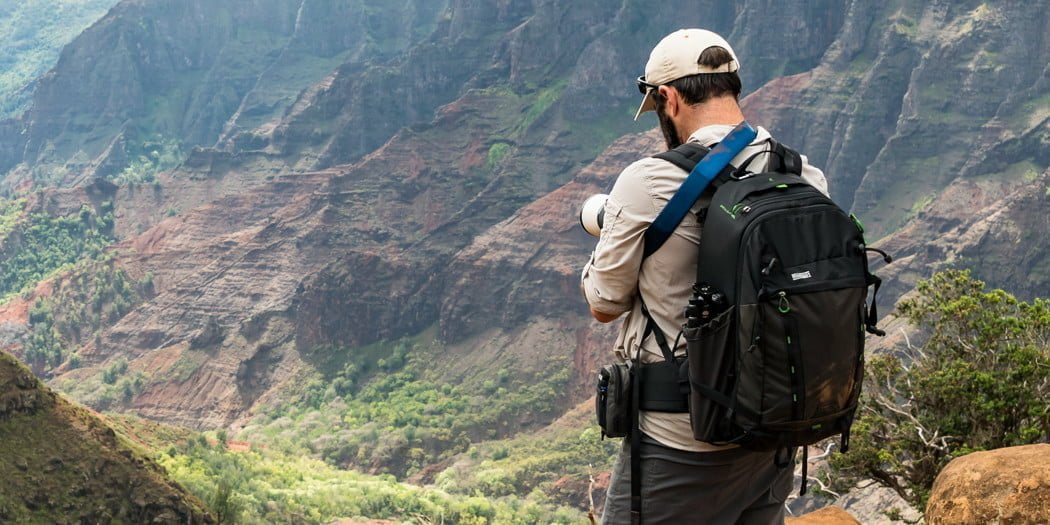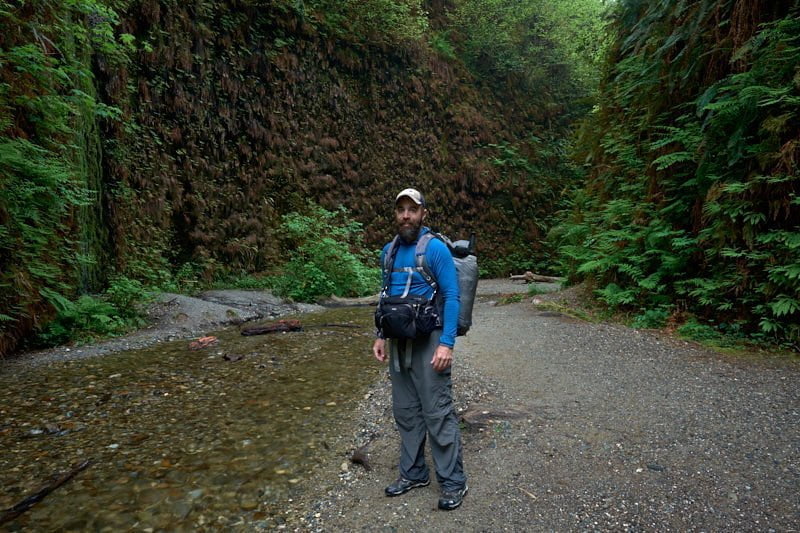Disclosure: This post may contain affiliate links. I earn a small commission of product sales to keep this website going.
The answer – like everything in photography – is, it depends. And most photographers have at least two different camera bags for different situations. Here’s some food for thought when you’re trying to decide between a camera backpack or a camera shoulder bag.
Carrying your camera and accessories during lightweight travel
There are a few basic requirements to keep in mind when looking at camera backpacks and shoulder bags.
- Protection. You’ve spent a lot on your gear. The bag should have adequate padding and prevent items from spilling out.
- Accessibility. If you’re actively shooting, you’ll need to be able to easily get to your gear so you can use it.
- Comfort. Discomfort from carrying your gear for long periods shouldn’t put you off from continuing your shoot.
- Organization. It should be easy to get to the gear you need without digging endlessly through cables and batteries. Your essential camera bag accessories should have dedicated compartments.
Both camera shoulder bags and backpacks fulfill these requirements. But choosing between a backpack or shoulder bag can be a difficult choice.
Camera backpacks
Camera backpacks don’t have a lot of disadvantages, but the ones they do have can be a pretty big deal. Otherwise, they’re a great way to store and transport your camera gear.
When camera backpacks are best
- Storing & transporting all your gear (via air, car, boat, etc)
- Long excursions by foot
- Shoots requiring extra gear such as tripod, drones, clothing, food, etc.
- Activity requiring a conformal, secure pack, such as bicycling
Advantages of camera backpacks
- Comfortable for long periods
- Excellent organization
- Secure against the body
- Most offer great gear protection
- Many offer attachment points for extra gear, creating modular solutions
Disadvantages of camera backpacks
- Large backpacks are bulky; prone to getting in the way while wearing
- Many camera backpacks are not very subtle or inconspicuous in populated areas
- Access mostly requires at least taking the pack partly off, which may discourage you from getting the camera out
How to choose a camera backpack
- Airline carry-on compatible if you’ll be flying a lot; you won’t want to check it
- Capable of carrying all the gear you would need at once, up to carry-on size if you plan on flying with it (if you’re a lightweight traveler this shouldn’t be an issue!)
- Ruggedness to withstand your personal style of adventure
- If you plan to wear it in an urban area, it should be small, inconspicuous, and offer theft protection (main compartment not accessible on the outside)
- A modular interior storage system will allow you to also carry clothing, food, etc.

Camera shoulder bags
Shoulder bags can be uncomfortable and don’t carry a lot of gear, but the quick access they provide make them a favorite method of carry.
When shoulder bags are best
- Wandering around the streets
- Tight quarters
- Short
trips - Small, light kits
Advantages of camera shoulder bags
- Fast, easy gear access
- Available in small sizes
- Capable of “blending in” in urban environments
- Many offer great organization & interior protection
- Some offer modular systems for customized options
Disadvantages of camera shoulder bags
- Uncomfortable when heavy and after long periods of continuous wear
- Can lead to musculoskeletal problems if not sized & worn correctly
- Can’t (shouldn’t) carry all of your gear at once
- Less secure on your body
- Awkward to carry larger gear like tripods
How to choose a camera shoulder bag
- Don’t size one based on the gear you have – size it based on what you would want to carry on your shoulder. Don’t fall for the bags that can carry seven lenses just because they can carry seven lenses. Ouch!
- In addition to sizing it based on how much you want to carry, also consider the minimum gear that you need when you’d be using this bag
- Choosing a shoulder bag that can carry an iPad/Mini is wonderful if you use it for processing photos or showing a portfolio
- If you plan on being in an urban or impoverished environment, choose a bag that isn’t “shiny” or advertises the camera inside
- Camera bags that include a
raincover are excellent investments for further protection

Other options besides camera backpacks and shoulder bags
Sometimes neither of these options will work…and you’ll need yet another bag.
Neither a backpack nor a shoulder bag will work while I’m backpacking in the wilderness, but I still want my camera protected and immediately available for photos.
I use this totally stylish hip belt (either Think Tank’s Speed Demon or Hubba Hubba Hiney) to carry around my waist and at least keep a camera & two lenses immediately available. All it’s missing is dayglo orange and green accents.

When you need the convenience of a shoulder bag but the comfort of a backpack, a sling bag is a good option. You can’t and shouldn’t carry a lot of gear in it, but it’s ideal for keeping a small kit both accessible and secure against your body.
Where to find great camera backpacks and shoulder bags
- Think Tank’s line of camera bags at B&H Photo Video
- Lowepro’s line of camera bags at B&H Photo Video
- Check out Tenba at B&H
Read more about my favorite camera bag manufacturers here
In conclusion
Unfortunately, I haven’t been able to find one camera bag that works for everything.
I love backpacks for transporting everything I need for the entire trip in a comfortable manner.
But shoulder bags win the award when I’m out and about shooting with a camera and extra lens or two, and want to have them quickly available to get the shot.
So I guess the answer
